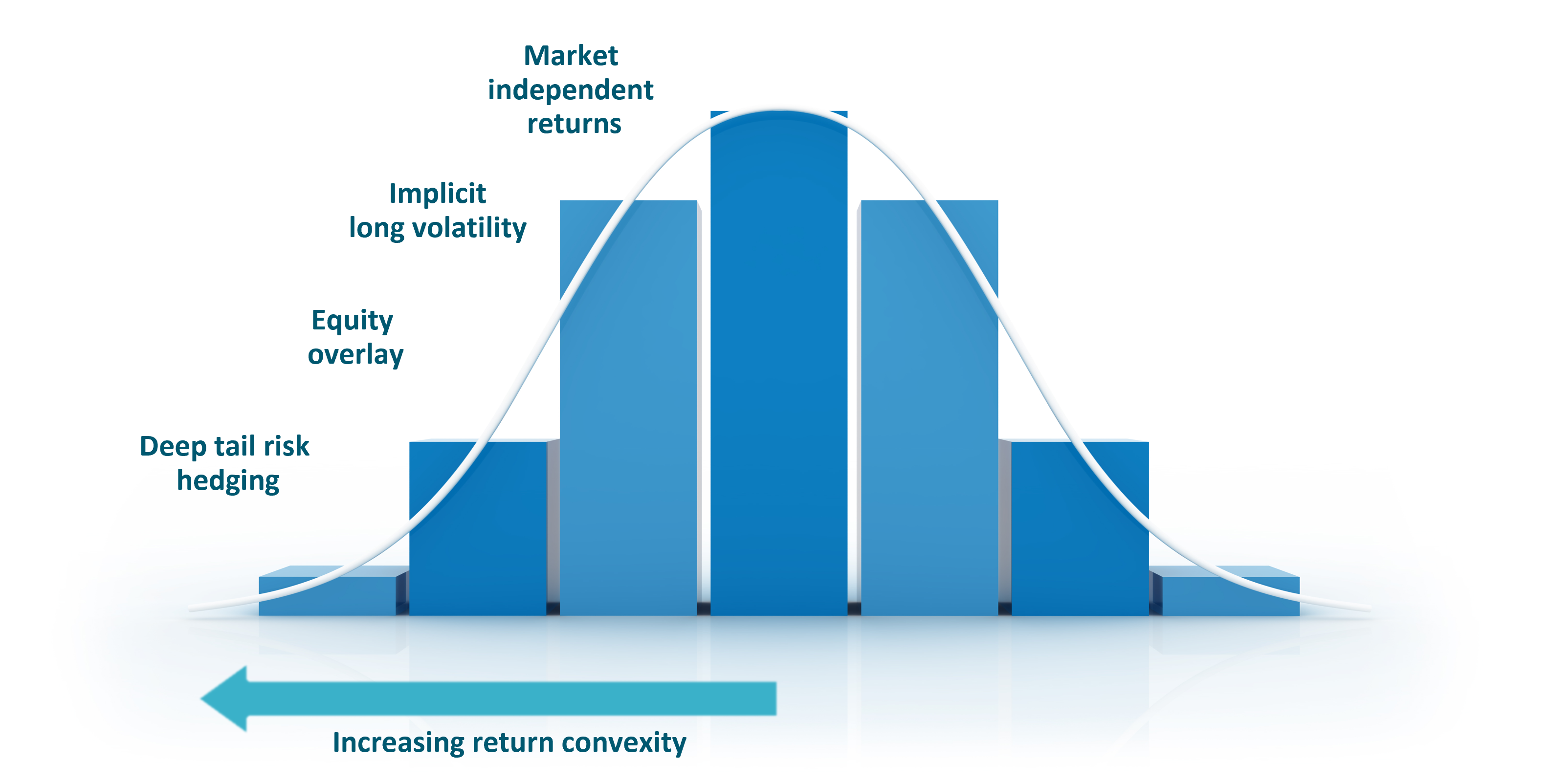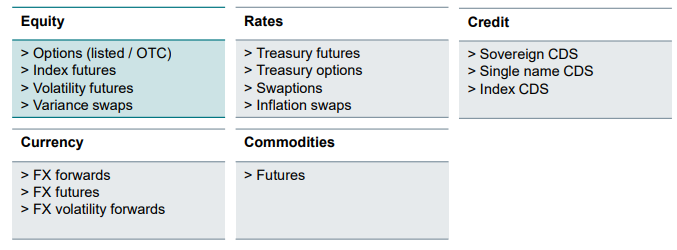bfinance insight from:

Toby Goodworth
Managing Director, Head of Liquid Markets
Following the considerable market losses endured in the first half of 2022, investors are taking the opportunity to weigh their own results and reassess resilience. Portfolio diversification, ‘defensive’ factors, ‘market-independent’ strategies and more explicit forms of protection such as risk overlays are all under scrutiny, with H1 bringing some notable disappointments as well as successes.
Classic diversifying and defensive strategies have not all provided the support that investors typically hope for at times when equity markets slump. CTAs and Macro hedge funds have delivered exceptionally strong performance year-to-date: the SocGen CTA index is up more than 20% in H1, with more trend-heavy strategies delivering over 30% on average. Many fixed income portfolios have of course been battered by rising rates. ‘Min vol’ did deliver, but ‘quality’ equity factors—typically thought to be defensive—have underperformed. [To request a copy of an upcoming bfinance white paper examining ‘defensive’ equity strategies, please
Equity risk overlays have yielded significant benefits for many investors over the past couple of years. It is, however, far from straightforward to implement a strategic approach in this area that works over the long term. Those that take on the burden of funding tail protection strategies without thorough long-term commitment at all levels of the governance structure may find themselves suffering the same fate as CalPERS, whose team abandoned its protection measures just before the Covid crisis—and lost out on well over a billion dollars in returns as a result.
There are, however, many different approaches to equity risk overlay management. They range from cheaper static protection programmes through to more complex dynamically managed strategies that may include implicit long volatility trading strategies alongside explicit (paid-for) protection—as explored DNA of a Manager Search: Equity Overlay from bfinance. Overlay programmes, by their very nature, should be highly customised to the specific investor’s needs, exposures and risk tolerance: these are not commoditised off-the-shelf solutions. In addition to using these measures for equity risk control, investors can also use overlays across a range of asset classes for a variety of risk-reducing or alpha-generative purposes, such as tactical asset allocation and currency risk management.
There are, we believe, six questions that investors should consider before pursuing an equity overlay programme. Anecdotal experience indicates that, where these questions are not addressed internally (or where there is considerable disagreement over the answers), attempts to implement programmes will often flounder.
Six portfolio protection questions to address
1. Which exposures are to be protected?
2. What range of losses are we protecting against?
3. What type(s) of drawdown are we protecting against?
4. When do we want protection to start and finish?
5. How much are we prepared to pay?
6. What instruments or asset classes should be permitted?
1. Which exposures are to be protected?
Investors may invest in many different equity markets around the globe, although market crashes do tend to send their correlations towards 1.0. Investors could of course be considering various other risks, such as exposure to international currencies versus the 'home’ currency, in which returns are measured and liabilities may be denominated. The discussion in this article is primarily focused on equity risk.
2. What range of losses are we protecting against?
Most long-term investors are perfectly happy to tolerate small-to-moderate losses in equity markets: portfolio diversification provides some resilience, while reduced valuations in more severe drawdowns often provide a buying opportunity. An investor considering overlays will need to determine how severe the market losses would have to be before they want protection to kick in and how deep they want that protection to go: it is very unlikely to be appropriate or cost-effective to protect out to -100%.
For equity market losses of different levels of severity, the appropriate solutions and investment strategies may differ—as illustrated in the chart and table below.


There are a range of strategies that may offer portfolio diversification of different flavours. ‘Market-independent’ strategies should provide usefully different return streams versus the exposures that one is seeking to protect (in this case equity risk) and typically have low equity beta (< 0.3) as well as limited convexity in their return profile.
Meanwhile, long volatility strategies can offer ‘heroic diversification’: decent returns at times when markets perform very poorly indeed. These strategies can be challenging to hold, with long periods of weak returns interspersed with less frequent outsized gains, but holding them does not involve an explicit cost.
When it comes to more severe market downturns, investors can find protection in derivatives. There are a rich variety of strategies, ranging from simple puts to more complex structures where protection can be dialled up and down based on market triggers. Some of these strategies have moderate convexity and low theta cost; others give highly convex crisis risk protection (>3σ moves). Deep tail risk hedging (at the more extreme end) can be harder to hold due to ongoing running costs with very infrequent payouts: this approach alone is likely to be less relevant for many long-term investors.
3. What type(s) of drawdown are we protecting against?
Market drawdowns vary by depth, speed and trajectory. As such, different protection strategies will be more or less suited to certain types of drawdown. The table below illustrates a variety of different market conditions—such as prolonged drawdowns versus sudden severe falls—and considers the protective strategies that may be more effective in that climate.
 *’Explicit protection’ means protection that is established in advance, with a dependable mechanism and known outcomes. It requires explicit costs to hold. This can be contrasted with ‘implicit protection’: this may have no explicit cost, but protection requires action (e.g. dynamic basis, trigger) and outcomes are uncertain (although statistically likely).
*’Explicit protection’ means protection that is established in advance, with a dependable mechanism and known outcomes. It requires explicit costs to hold. This can be contrasted with ‘implicit protection’: this may have no explicit cost, but protection requires action (e.g. dynamic basis, trigger) and outcomes are uncertain (although statistically likely).
4. When do we want protection to start and finish?
Investors must give great care to the question of time horizon. Again and again, we learn the lesson that portfolio protection should be a strategic decision—not a tactical trade. There are instances when temporary protection may be appropriate, such as protecting committed capital or protecting a portfolio to a specific valuation date. Yet, more broadly, attempts to time the introduction of overlays rarely work well and end up reducing their credibility in the eyes of stakeholders. Effective risk overlay management as a portfolio construction tool requires long-term commitment and should be implemented in a way that is tolerable (particularly from a cost standpoint) over many years: the goal is to protect against infrequent but materially detrimental downturns that will occur from time to time.
5. How much are we prepared to pay?
There are two major forms of expense involved in equity risk overlays: premium costs and collateral requirements. An equity risk overlay designed for a typical pension plan portfolio might require funding with 3%-7% collateral and a premium spend of around 1%-2% per year.
Premium costs—the running costs of a protection strategy—are dynamic and are a function of multiple parameters: market volatility, demand for protection (skew), and the type of protection required (amount, duration, style, depth). Explicit protection strategies require an ongoing premium spend, but can be made cheaper or even premium-neutral by selling the upside to fund the downside (e.g. collar protection).
Futures-based strategies (for ‘implicit’ protection) don’t have these running costs in the same way, but do still need to be funded. Here the efficiencies afforded through margin-funded exposures allow overlays to be held on top of existing portfolio allocations, meaning that strategic asset allocation or long-term exposures do not need to be disrupted.
6. What instruments or asset classes should be permitted?
Some investors are restricted in the types of instruments that they are allowed to use. These constraints should be considered with care when deciding to implement an overlay structure. Overlay strategies require unfunded or margin-funded instruments—options, futures, swaps and so forth—in order to 'overlay’ physically-held (or cash-funded) investments. There is a huge universe of overlay-appropriate instruments, including a core universe of equity and equity-related derivatives.

Finding a way forward
While investors do not need to have fully defined views on all six of these questions up front, honest discussions about them among the investment team, risk team and board will lay the groundwork for making robust, well-supported decisions. While advisors and overlay providers can help investors to define their views on these points—like architects designing a home extension—it is important to ensure that guidance is closely aligned with investors' specific needs, tastes and cost sensitivities.
Overlays are not for everyone. And they should not be used as a sticking plaster for strategy: it is always crucial to address whether the underlying exposures and the approach to strategic/dynamic/tactical asset allocation are actually appropriate before attempting to modify them through overlays. In the right context, however, they can represent a valuable portfolio construction tool.
Important Notices
This commentary is for institutional investors classified as Professional Clients as per FCA handbook rules COBS 3.5R. It does not constitute investment research, a financial promotion or a recommendation of any instrument, strategy or provider. The accuracy of information obtained from third parties has not been independently verified. Opinions not guarantees: the findings and opinions expressed herein are the intellectual property of bfinance and are subject to change; they are not intended to convey any guarantees as to the future performance of the investment products, asset classes, or capital markets discussed. The value of investments can go down as well as up.


 English (Global)
English (Global)  Deutsch (DACH)
Deutsch (DACH)  Italiano (Italia)
Italiano (Italia)  Dutch (Nederlands)
Dutch (Nederlands)  English (United States)
English (United States)  English (Canada)
English (Canada)  French (Canada)
French (Canada) 

